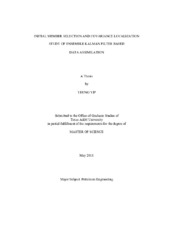| dc.description.abstract | Petroleum engineers generate reservoir simulation models to optimize production and maximize recovery. History matching is one of the methods used to calibrate the reservoir models. During traditional history matching, individual model variable parameters (permeability, relative permeability, initial water saturation, etc) are adjusted until the production history is matched using the updated reservoir model. However, this method of utilizing only one model does not help capture the full range of system uncertainty. Another drawback is that the entire model has to be matched from the initial time when matching for new observation data.
Ensemble Kalman Filter (EnKF) is a data assimilation technique that has gained increasing interest in the application of petroleum history matching in recent years. The basic methodology of the EnKF consists of the forecast step and the update step. This data assimilation method utilizes a collection of state vectors, known as an ensemble, which are simulated forward in time. In other words, each ensemble member represents a reservoir model (realization). Subsequently, during the update step, the sample covariance is computed from the ensemble, while the collection of state vectors is updated using the formulations which involve this updated sample covariance.
When a small ensemble size is used for a large, field-scale model, poor estimate of the covariance matrix could occur (Anderson and Anderson 1999; Devegowda and Arroyo 2006). To mitigate such problem, various covariance conditioning schemes have been proposed to improve the performance of EnKF, without the use of large ensemble sizes that require enormous computational resources.
In this study, we implemented EnKF coupled with these various covariance localization schemes: Distance-based, Streamline trajectory-based, and Streamline sensitivity-based localization and Hierarchical EnKF on a synthetic reservoir field case study. We will describe the methodology of each of the covariance localization schemes with their characteristics and limitations. | en |


